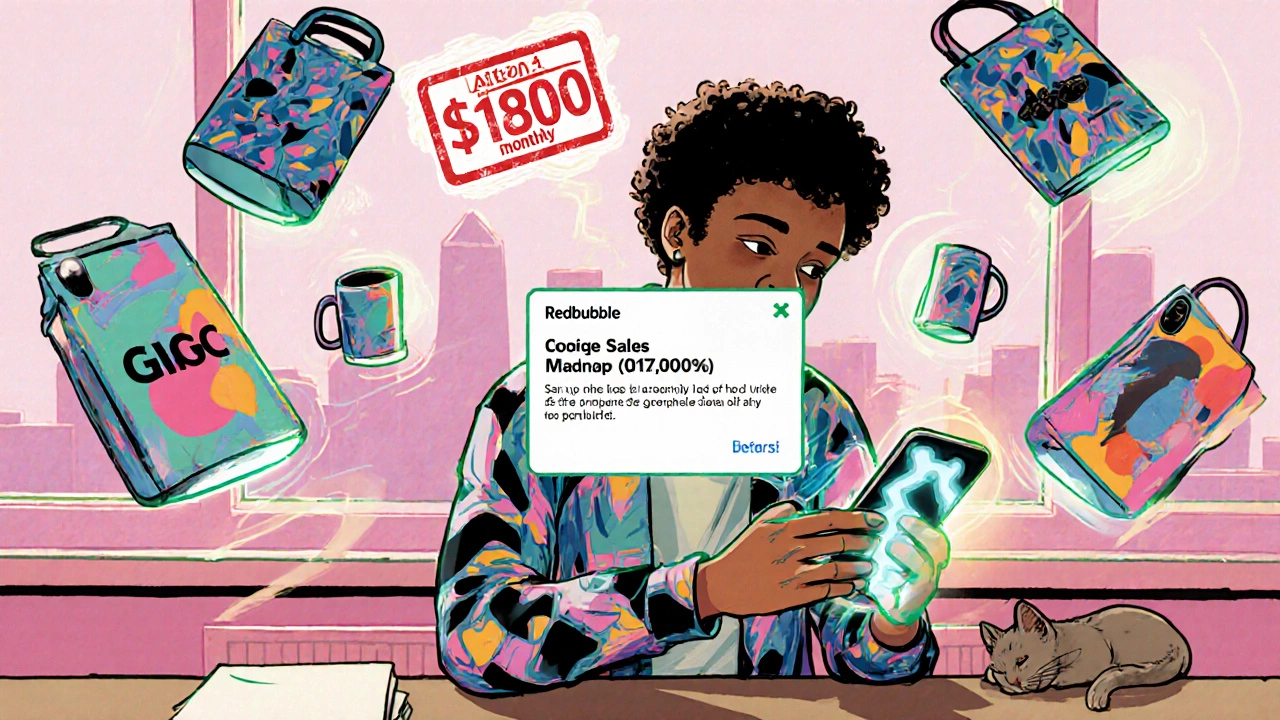Digital Art Earnings Calculator
Estimated Annual Income
$0
* Wellington artist: $1,420/month
* Berlin artist: $96,000/year (Patreon)
* Auckland generative artist: $178,000/year (NFTs + royalties)
Yes, digital art can make money-but not the way most people think. It’s not about posting pretty images on Instagram and hoping someone buys a print. Real income comes from strategy, platform choice, and understanding who values your work. In 2025, digital artists aren’t just surviving-they’re building full-time careers, some earning six figures, without ever touching a canvas.
How digital art makes money in 2025
The biggest shift since 2020 isn’t the tech-it’s the trust. Buyers now know digital art isn’t just a JPEG. It’s ownership, provenance, and scarcity, thanks to blockchain and verified marketplaces. Artists earn through five main channels: NFTs, licensing, commissions, subscriptions, and print-on-demand.
NFTs still dominate high-value sales. Platforms like Foundation and a curated NFT marketplace where artists verify their identity and sell limited editions and SuperRare a platform focused on high-end digital collectibles with verified creators let artists sell one-of-a-kind pieces with smart contracts that pay royalties on every resale. A digital painting sold for $80,000 on Foundation in May 2025 went on to earn the artist $12,000 in secondary royalties over six months.
Licensing is quieter but more reliable. Brands, game studios, and even fashion houses pay $500-$5,000 per asset for exclusive rights to use your art in ads, apps, or virtual worlds. One Wellington-based artist made $37,000 in 2024 licensing stylized flora designs to a mobile game developer.
Commissions are the bread and butter for emerging artists. Clients pay upfront for custom portraits, character designs, or album covers. Rates range from $150 for simple pieces to $2,500+ for complex, multi-layered work. Many artists use Patreon a membership platform where fans pay monthly for exclusive content to lock in steady income-1,200 subscribers paying $8/month equals $96,000 annually before taxes.
Print-on-demand services like Redbubble an online marketplace for artists to sell prints, apparel, and home goods and Society6 a platform that prints and ships art on products with no upfront cost to the artist turn digital files into physical products. A single design sold as a phone case, tote bag, and poster can generate passive income for years. One artist in Auckland made $1,800 last month just from a single abstract pattern.
What digital art sells best
Not all digital art sells equally. Buyers look for three things: emotional impact, uniqueness, and utility.
Portraits and stylized characters perform well. People want to own something personal-even if it’s not them. Fantasy characters, anime-inspired figures, and surreal self-portraits consistently top sales charts on OpenSea and ArtStation.
Abstract and generative art thrives in the NFT space. Algorithms that create evolving visuals-like those made with Processing or p5.js-are popular because they feel alive. One generative series called "Echoes of the Southern Lights" sold 412 pieces on Foundation, each priced between $120 and $1,200, with the artist earning $28,000 in primary sales and another $9,000 in royalties.
Utility matters. Art that works in virtual worlds-like Decentraland or Roblox-is in demand. Designers who create wearable digital fashion, HUD elements, or environment assets get paid by developers who need ready-made assets. A single 3D wearable sold for $5,000 on OpenSea last month.
On print platforms, nature themes dominate: forests, oceans, and galaxies. Minimalist geometric patterns also sell well on mugs and posters. Avoid clichés like "space cats" or "cute skulls"-they flood the market and drive prices down.
Where to sell digital art
You need the right platform for your goal. Here’s what works in 2025:
- NFT marketplaces (Foundation, SuperRare, OpenSea): Best for high-value, limited-edition pieces. Requires wallet setup and gas fees, but offers royalties on resales.
- ArtStation: The go-to for illustrators and game artists. Offers direct sales, commissions, and a job board. No blockchain needed.
- Etsy: Surprisingly effective for digital downloads. Sell printable wall art, SVG files, or Canva templates. Low barrier to entry.
- Patreon: Ideal for building a loyal fanbase. Offer early access, tutorials, or exclusive brushes.
- Redbubble/Society6: Passive income. Upload once, sell forever on hundreds of products.
- Instagram and TikTok: Not direct sales channels, but essential for discovery. Use hashtags like #DigitalArtForSale and #NFTArtist to attract buyers.
Top performers use a mix: a NFT collection to build prestige, Patreon for recurring income, and Etsy for low-effort sales. One artist in Berlin sells NFTs on Foundation, offers monthly brush packs on Patreon, and lists 12 digital prints on Etsy-all from the same 8 core designs.
What doesn’t work anymore
Many artists waste time on outdated methods.
Posting on DeviantArt or Behance hoping for sales? Those platforms don’t pay. They’re portfolios, not storefronts. If you’re not directing traffic to a sales page, you’re not earning.
Buying fake followers? It backfires. Buyers check engagement. A post with 50 likes from real collectors means more than 5,000 likes from bots.
Chasing trends like "AI-generated art" without adding your own hand? The market is flooded. Buyers now look for human touch-brushstrokes, texture, intentional imperfections. AI tools help, but they’re assistants, not replacements.
Ignoring taxes and legal contracts? Big mistake. In New Zealand, Australia, and the EU, digital art sales are taxable income. Always use contracts for commissions-even if it’s just a simple Google Doc with terms, payment, and usage rights.
How to start making money this month
You don’t need a big following or expensive tools. Start here:
- Choose one platform to focus on. If you’re new, pick Etsy. Upload 5 digital prints with clear descriptions and tags like "digital wall art," "modern abstract print," "instant download."
- Create one freebie: a downloadable wallpaper or color palette. Offer it in exchange for email sign-ups. Build a list.
- Post 3 times a week on Instagram or TikTok showing your process-time-lapses of your brushwork, your tablet, your studio. Use audio of your music or ambient sounds.
- Reach out to one small business: a local café, a musician, a yoga studio. Offer a custom digital piece for their wall or app in exchange for exposure.
- Set up a simple PayPal or Stripe link. Make it easy to pay.
One artist in Wellington did this in October 2025. She uploaded 7 prints to Etsy, posted daily process videos, and offered a free desktop wallpaper. By the end of the month, she made $1,420-$980 from Etsy, $320 from commissions, and $120 from a Patreon subscriber who saw her work on TikTok.

Real artists, real earnings
Meet Lena, 29, from Christchurch. She paints digital portraits of pets. She sells them on Etsy for $45 each. She also offers a $120 "premium" version with animated eyelids and a custom frame. She posted 12 pieces last month. Sold 18. Made $1,170. Her best month? $3,200 during Pet Adoption Month.
Then there’s Raj, 34, in Auckland. He makes generative art using code. He released a collection of 1,000 pieces on Foundation. Each sold for 0.05 ETH ($150). He earned $150,000 in primary sales. Secondary sales have added $28,000 in royalties so far. He now teaches coding for artists on Patreon-another $8,000/month.
These aren’t outliers. They’re everyday people using digital tools to build income streams that scale.
What you need to get started
You don’t need a $2,000 tablet. A $100 Huion tablet or even an iPad with Apple Pencil works. Free software like Krita or FireAlpaca can replace expensive programs.
You need:
- A clear style-even if it’s simple
- A way to deliver files (PDF, PNG, ZIP)
- A payment method (PayPal, Stripe, crypto wallet)
- One platform to start with
- Consistency: post or sell something every week
Success doesn’t come from talent alone. It comes from showing up, testing what sells, and repeating what works.
Can you make a living from digital art?
Yes, but not overnight. Top digital artists earn $50,000-$300,000 a year by combining multiple income streams: NFT sales, commissions, licensing, and subscriptions. Most start with side income and scale over 1-3 years. The key is consistency, not virality.
Do I need to use NFTs to make money?
No. NFTs are just one channel. Many artists earn more from Etsy prints, commissions, or licensing than from NFTs. NFTs work best for high-concept, limited-edition work. For portraits, patterns, or illustrations, traditional digital sales often pay better and with less risk.
How much should I charge for digital art?
Start with $25-$75 for simple digital prints. For custom commissions, charge $100-$500 depending on complexity. For NFTs, research similar artists on Foundation or OpenSea. A good rule: price your first NFT collection at 0.03-0.1 ETH ($50-$150) to attract early buyers. Raise prices as you gain traction.
Is digital art considered real art?
Yes. Major museums like the Tate and MoMA have acquired digital works. The medium doesn’t define the art-intention, skill, and emotion do. A digital painting with 100 layers, hand-painted brushwork, and emotional depth is just as valid as an oil painting.
What’s the easiest way to start earning?
Upload 5 digital prints to Etsy. Use keywords like "digital wall art," "modern abstract print," "instant download." Make sure your files are high-res PNGs. Set a price between $10-$25. Promote your shop on Instagram with a short video of your artwork appearing on a wall. Most sellers make their first sale within 2-4 weeks.
Next steps
If you’re just starting, pick one action: upload a print to Etsy today. Or post your first process video on TikTok. Don’t wait for perfect tools or perfect skills. The market is hungry for authentic, human-made digital art. Your next sale is waiting-not in a gallery, but in someone’s phone, on their wall, or in their virtual world.

